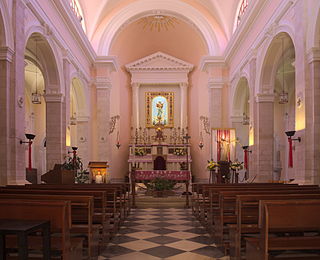
The Catholic Church in Greece is part of the worldwide Catholic Church, under the spiritual leadership of the Pope in Rome. Indigenous Roman Catholic Greeks numbered about 50,000-70,000 in 2022 and were a religious and not an ethnic minority. Most of them are a remnant of Venetian and Genoese rule in southern Greece and many Greek islands from the early 13th until the late 18th century, Greeks who converted to Catholicism or descendants of the thousands of Bavarians that came to Greece in the 1830s as soldiers and civil administrators, accompanying King Otto. One very old but still common term to reference to them is Φράγκοι, or "Franks", dating to the times of the Byzantine Empire, when medieval Greeks would use that term to describe all Catholics.
The Roman Catholic Diocese of Tinos (and Mykonos) was a Latin suffragan diocese on some of the Aegean islands of Greece.
The Roman Catholic Diocese of Andros was a Latin Catholic bishopric in insular Greece. In 1919, it was absorbed by the Roman Catholic Archdiocese of Naxos, Andros, Tinos and Mykonos.

The Diocese of Crete is a Latin Church diocese of the Catholic Church located on the island of Crete in the ecclesiastical province of Naxos, Andros, Tinos and Mykonos in Greece.
The Diocese of Chios is a Latin Church diocese of the Catholic Church located on the island of Chios in the ecclesiastical province of Naxos, Andros, Tinos and Mykonos in Greece.
The Roman Catholic Diocese of Santorini is a diocese of the Catholic Church located in the city of Santorini in the ecclesiastical province of Naxos, Andros, Tinos and Mykonos in Greece.

The Diocese of Syros and Milos is a Latin Church diocese of the Catholic Church located in the cities of Syros and Milos in the ecclesiastical province of Naxos, Andros, Tinos and Mykonos in Greece.

The Apostolic Vicariate of Thessaloniki is a Latin Church ecclesiastical territory or apostolic vicariate of the Catholic Church in northern continental Greece.
The Holy Synod of Catholic Bishops of Greece is the Episcopal Conference in Greece. It is a member of the Council of European Bishops' Conferences and sends a representative to the Commission of the Bishops' Conferences of the European Community (COMECE).
The Diocese of Cephalonia and Zakynthos was Roman Catholic diocese located on the Ionian Island of Cephalonia. It was suppressed in 1919.
Roberto de Noya, O.P. or Roberto de Noja was an Italian Roman Catholic prelate who served as Archbishop of Naxos (1504–1515), Bishop of Acerra (1497–1504), and Bishop of Minervino Murge (1492–1497).
Marco Antonio Quirino, O. Cruc. or Marco Sebastianus Quirino was a Roman Catholic prelate who served as Archbishop of Naxos (1622–1625).
Pietro Martire Giustiniani, O.P. (1645–1715) was a Roman Catholic prelate who served as Archbishop of Tinos (1700–1715) and Archbishop of Naxos (1691–1700).
Antonio Giustiniani, O.P was a Roman Catholic prelate who served as Archbishop of Lipari (1564–1571) and Archbishop of Naxos (1562–1564).
Georgios Xenopoulos, SJ was a Greek Jesuit and prelate of the Catholic Church. From 1947 until his retirement in 1974, he was the Bishop of Santorini and the Bishop of Syros. In addition, he was at various times the apostolic administrator of the Archdiocese of Athens, the Diocese of Crete, and the Apostolic Vicariate of Salonica. He died in 1980, aged 81.
Antonio Giustiniani" was a Roman Catholic prelate who served as Roman Catholic Archbishop of Naxos (1701–1730), Bishop of Syros and Milos (1694–1701), and Vicar Apostolic of Smyrna (1690–1694).
Francesco Pisani was a Roman Catholic prelate who served as Archbishop of Chioggia (1569–1572) and Archbishop of Naxos (1564–1569).
Angelo Gozzadini (1573–1653) was a Roman Catholic prelate who served as Bishop of Civita Castellana e Orte (1621–1653) and Archbishop of Naxos (1616–1621).
Ioannis Perris was a Catholic Archbishop of Naxos, Andros, Tinos and Mykonos from October 24, 1960, to April 29, 1993.



